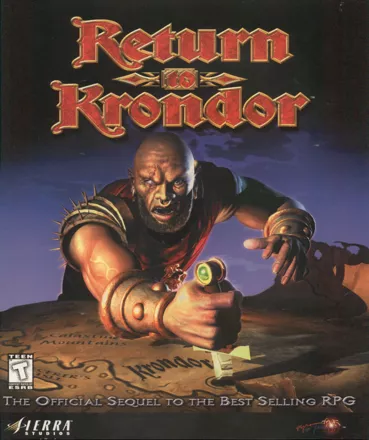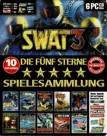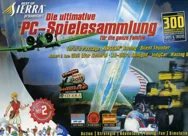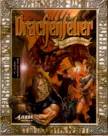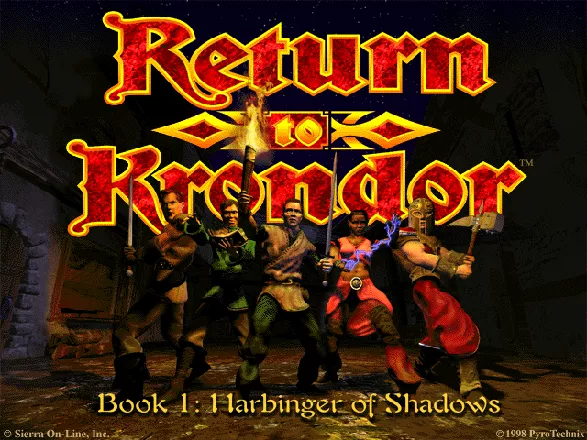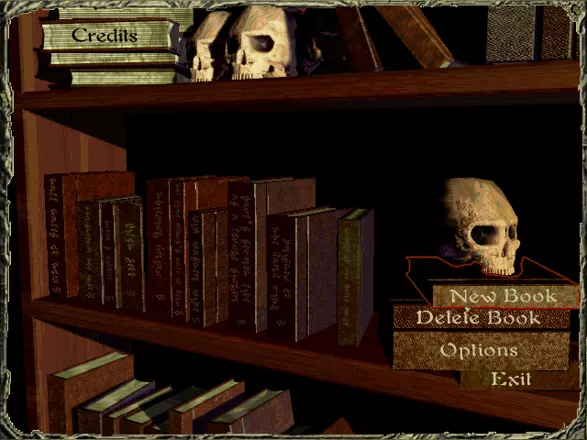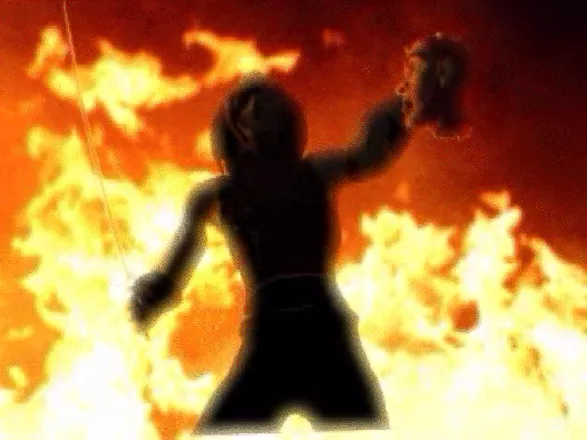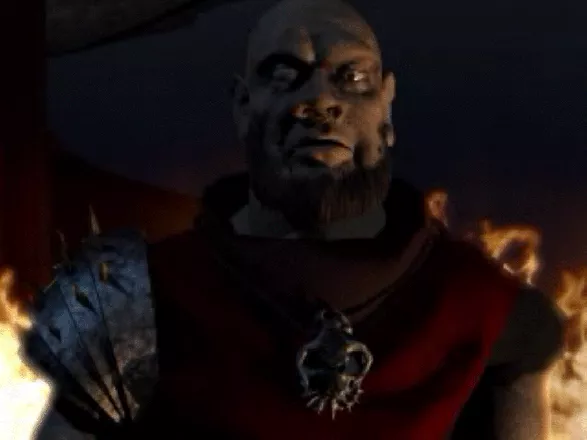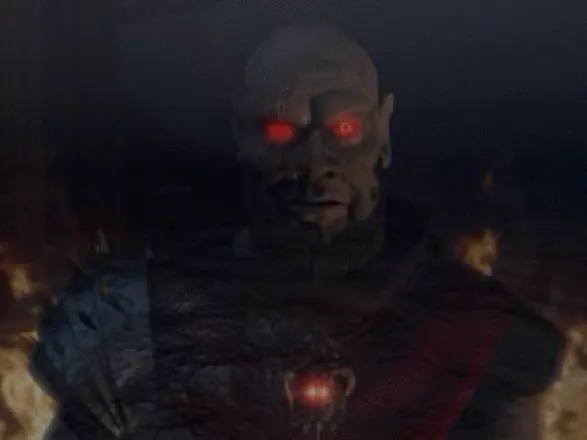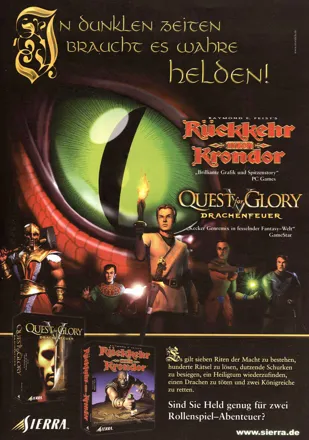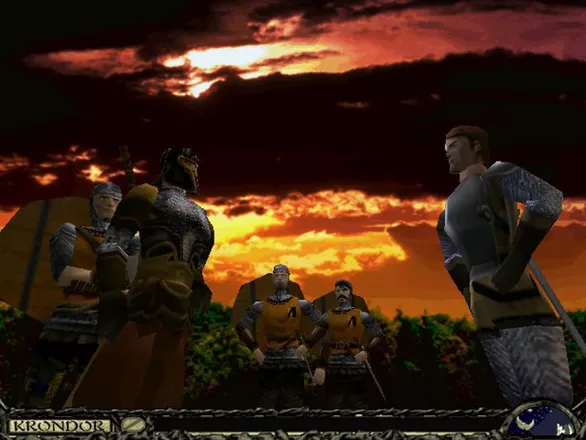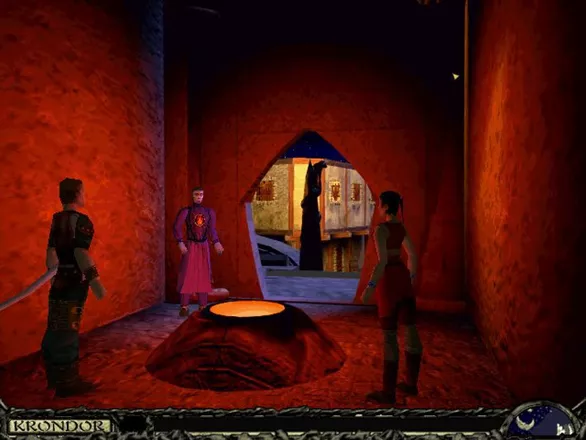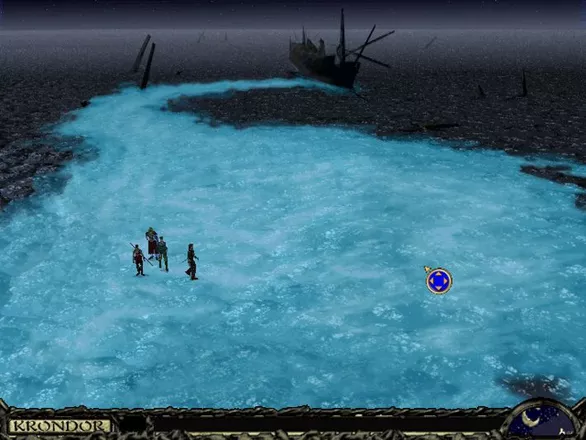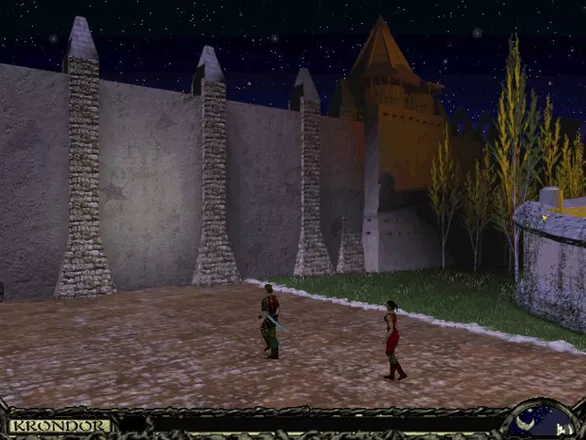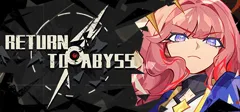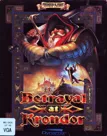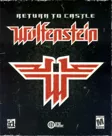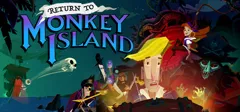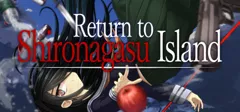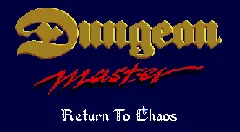Return to Krondor
Description official descriptions
The direct sequel to Betrayal at Krondor, Return to Krondor takes the player back to the fantasy world of Midkemia, which is once more in peril.
It all begins when James - once a thief and now a squire of Krondor - is sent by Prince Arutha to escort the court magician Jazhara to the palace. Shortly afterwards they meet William ConDoin, a fearless swordsman and the son of the famous magician Duke Pug. A ruthless mercenary named Bear sends his men to murder the woman William loves. It appears that Bear is in pursuit of the Tear of the Gods, a holy artifact of immense power. James and his friends follow the trail of death and destruction Bear has left in his wake and to stop him before he reaches the Tear. As they progress in their travels they discover that someone or something is creating dark beings and horrible perversions of nature, suggesting that things are very wrong in Krondor besides the ambitions of a single renegade mercenary.
Return to Krondor features pre-rendered backgrounds with changing camera angles for exploration, and 3D character models. Battles occur when contact is made with a hostile character, and are turn-based, including the tactical element of moving the characters manually over the battle field. The player controls James and three other characters who join the party. Compared to its predecessor, the game is less heavy on exploration, having smaller and more confined areas. Much of the game takes place in the city of Krondor, which is divided into several districts; later in the game the player gains access to other locations, though it is impossible to physically explore the overworld. Several side quests, however, are still available, in addition to pursuing the main storyline.
Unlike its predecessor, the game features a more common leveling up system where characters gain a set amount of skill points after having accumulated enough experience to level up. These skill points are allocated manually by the player to increase the characters' weapon proficiencies, defense, spellcasting, etc. The game also allows the player to brew potions via an alchemy system, and features a detailed lockpicking minigame that involves choosing between several available tools and applying them to the lock.
Spellings
- בחזרה לקרונדור - Hebrew spelling
- 重返克朗多 - Chinese spelling (traditional)
Groups +
Screenshots
Promos
Credits (Windows version)
118 People (116 developers, 2 thanks) · View all
| Executive in Charge | |
| Lead Engineer | |
| Game Design and Story Consultants | |
| Game Software Engineers | |
| True3D Software Engineers | |
| [ full credits ] | |
Reviews
Critics
Average score: 74% (based on 30 ratings)
Players
Average score: 3.4 out of 5 (based on 30 ratings with 4 reviews)
If you missed the chance to play "Betrayal at Krondor" this will makes it all worthwhile...
The Good
To say what is good about the game is a tough one, because everything in the game is a perfect blend of a superb RPG. The graphics are excellent, with a touch of a Quest for Glory game play. The music is definitely original (and you can save it for your personal use) and you gotta love battle mode.
The Bad
Although I do call this an excellent game, the faults of the game are much easier to remember than the good stuff.
The game lacks originality, just another extension of your typical Quest for Glory and similiar RPG's. The isn't enough random encounters, it kinda funny playing an RPG where you have to find your enemies. I do recall the fabulous days of AD&D where "too many" enemies was never enough.
Unfortunately in this game if you follow the game plot to strictly you'd end up finishing the game "too" quickly, so it is advised to take as long as possible in playing the game.
It was kinda disappointing that the game play was different from Betrayal at Krondor, where you were expecting the "Doom" type view (what do you call that..?) but the battle mode didn't change that much so it really doesn't matter.
Despite the bad stuff I said about the game, its still a "Best-Buy" in my book.
The Bottom Line
RPG priority 1.
Windows · by Indra was here (20735) · 2002
Your Destiny Lies At The Bottom Of The Bitter Sea
The Good
1998 was quite a year for the CRPG (Computer Role Playing Game). Baldur's Gate as well as Return To Krondor were released. These two epic CRPGS would usher in a new age of CRPG goodness.
Of those two aforementioned games, RTK was by far the better. Indeed the long awaited sequel to 1996's epic Betrayal at Krondor.
RTK is far more linear than its processor, but still a most excellent game. There are some similarities of course, to BAK, such as an epic story based in Midkemia, co-written by bestselling fantasy author Raymond E. Feist. The combat system is also similar, it's basically a turn based tactical system, and to use the vernacular it rocks. A unique "bonus" system, randomly grants either the hero's or villain’s a round bonus, such as Hero's Refreshed, or Villain’s Rally.
As mentioned the game play is linear, explore, combat, explore some more. Though there are some fun side quests to undertake and to break up the otherwise linear game play.
The story of course is excellent; it truly feels like you are part of one of Mr. Feist's tales. And in true fantasy novel fashion a simple task leads the hero's into a terrible plot that endangers the Kingdom of the Isles and the very Gods!
The music and sound have to be seen to believed. The epic score is up to if not surpassing most Hollywood movies. The voice work and sound effects are also high-quality.(Some of the voice actors you may even recognize from other games and TV. shows)
The Graphics are (still) amazing. With the inhabitants of Midkemia done in polygons, while the locales are done with down right awe inspiring pre-rendered backdrops.
Nice cinematics are also sprinkled throughout.
The game is short (25 hrs 1st time) but for those few hours you will be addicted. And when it's over you will swear that you have visited Midkemia, and had a hand in an epic adventure.
The Bad
The ending while excellent implies a sequel, which I fear will never see the light of day, perhaps in book form?
Not for novice CRPGers.
The Bottom Line
One of the best CRPGs ever made; if you missed it what's the excuse? The game can be found (eBay, Amazon) for under $20. And even new computers can run it with no trouble. I just played through it again on my new PC that is less than six months old.
Fans of rpgs, fantasy, and books will enjoy this one. If you are a Feist fan you owe it to yourself to play this game!
Windows · by MasterMegid (723) · 2005
The ending rivals some of the best RPGs ever made.
The Good
Return to Krondor has been sitting on my shelf for years. I had tried to play it a long while back, but for some reason didn't get very far and quit. I decided to try it again in 2004 with my new Windows XP P4 system and the last patch applied. And I'm glad I did!
Installation and gameplay was flawless. You are prompted to insert the second disc only at a certain plot point, and since the story is linear, you'll keep the same CD in your drive for great lengths of time (unless you restore an earlier save). The 59-page manual is well written and leaves out just enough so some of the gameplay surprises aren't ruined. Saving and loading is easy and you can name your saved games, although with too small a number of letters for my taste.
While I was playing, my non-game-player husband would peak in on me off and on, especially when he noticed that I had turned up the volume. He'd take a look at the screen and make random comments or ask questions. Here are a few of the dialog exchanges I recall which will give you a feel of what RtK was like:
"The music is great - Listen to those violins!", he said. "You can tell it was made by Sierra.", I answered.
(Ain't it the truth! Sierra had a knack for contracting great musicians for their games. Oh how I miss them sometimes.)
"That game looks different than the last RPG you played. No races or stuff to choose." To which I commented, "They're preset in this one."
(All characters are predestined so you don't need to worry about roles, races, professions etc. You can choose how their skills are divided so the gameplay leans towards your preference - Fighting, Balanced or Mage. They call it "Game Focus". I chose the Balanced for my first time through .. and the Easy setting.)
He commented, with a smirk on his face, "He runs funny .. like he's got a log between his legs!" [snicker, snicker] Grinning, I answered, "Hey .. maybe he does! He really doesn't move around very well, does he."
(Running does look pretty silly. Movement overall is rather clunky throughout. In some screens, though, it's possible to change the camera angle which helps tremendously - especially in very small rooms or while in combat. Using the arrow keys is necessary in some tight areas where a mouse click is not adequate.)
"What're ya doin' now?", he'd ask. "Trying to figure out how to unlock this trapped chest.", I said. And then, "Oops! That didn't go very well ... I guess I'd better restore and try that again!"
(The "bookmark" Quick Save and Quick Load rescued me often. It really didn't take long too figure out "reflex" lockpicking. Piece 'a cake! Reflex lockpicking, versus "Dice Roll" (based on luck and attributes), is something you choose in the beginning.)
"This is a long game. I thought you'd be finished by now!" I replied, "No, I'm not finished yet! I've just started Chapter 3. Now I can do all sorts of cool stuff - like use all that alchemy equipment to mix up my own potions. But first I have to learn the recipes and get all of the ingredients."
(The strong variations of some potions - like Healing - can only be found by making your own. The process is so realistic that I can imagine what it would've been like to actually be a mage. The drawback is that you have to lug around all of the heavy, space-hogging equipment everywhere - that is, if you want to make something on the road.)
And later, during a battle sequence, he commented, "Why is everybody all bunched up together? Can't you spread them out?" To which I replied, "I have to wait for their turn. And that'll take awhile."
(Most of the time, James and his party are arranged in a triangular fashion when the battle first begins. There are limits as to where each person can move on the screen, and that takes a few "turns" to accomplish. If you can't get close enough to an enemy to use a close combat weapon, you may need to end the turn without accomplishing a darned thing.)
"Why can't she cast a spell now?", he remarked while watching me work out battle strategy. To that I told him, "Well, she'll have to drop her weapon first .. and then I'll need to remember to find it on the ground!"
(This part was stupid. Mages & priests should be able to cast spells even while armed with a weapon. Or, at least, drop it into their backpack - not on the ground.)
How often have you gone through a long game, such as this one, defeated the last, most powerful enemy and gotten a crappy ending? An ending that left you saying ... "Is that all there is?" Without giving too much away, I'll tell you that Return to Krondor's ending is one of the best I've ever seen!! There are dying words, expressions of pain and anguish .. plus a lover's last kiss, conversations amongst the heroes, congratulations and accolades from their lord. And ... after the credits finish, a final scene! (T'would have even made Lord British envious!)
The Bad
Specific actions on the player's part trigger advancements in the story. If you've cheated (by referring to a guide) and know where those are, you can speed up your game (or slow it down). Or, if you don't know where they are, you might end a "chapter" earlier than you should - with characters too wimpy to beat even a rookie brigand. Luckily the start of each chapter is "auto-saved" if you make that mistake.
The graphics are in keeping with a 1998 game, in a no frills sort of way. As you can see from some of the screenshots here on MobyGames, the characters are blocky (no fingers in the hands, for instance - reminiscent of the Elder Scrolls game Redguard, coincidentally released the same year). Krondor and the outlying territories are depicted nicely albeit simply. During the portions leading to the "end game" I did notice some pixel overlap in several screens. Characters seemed to walk -through- the other on-screen graphics, in other words. (The animations in the cut-scenes are pretty darned good, however.)
While inventory is fairly easy to use, there are some inconsistencies relating to design. Some "like" objects (i.e. flasks and alchemy ingredients) are grouped into one slot, while potions and scrolls that are alike take up individual slots. New additions to inventory go into the first available slot, but their positions change when you look later. The player cannot permanently change their arrangement, but that's okay.
It was disconcerting not being able to rest or cast spells during Chapters 1 and 2. You are attempting to build up your experience and equipment (money) during these crucial first chapters, so I do not understand the reasoning behind this.
In many other games, enemies -and oodles of them- abound and you don't need to go looking for them .. they either just appear or come looking for you. Not so in RtK. Most encounters in this game are randomized .. and you must seek them out in various places (mostly inside buildings in the beginning at least). I really didn't dislike this element, but it really is unique.
The Bottom Line
Some have said that RtK has too much Quest for Glory in it to be called a real RPG. For diehard AD&D gamers that may be true because this game has a distinctively different flavor to it.
But, it is decidedly not a QfG game! There's plenty of story, yes, but combat and spellcasting are the primary facets of gameplay. Only one "puzzle" exists and it was a hit-and-miss logic type puzzle, but there are no other "adventure" aspects (unless you count questing). Also absent is "action" - no jumping or swimming - which I consider a plus.
I heartily recommend Return to Krondor as a good RPG and worth playing - mostly because the ending is one of the best I've ever experienced.
Windows · by Jeanne (75814) · 2007
Trivia
Return to Krondor is sub-titled Book 1: Harbinger of Shadows because it was the first part in a planned series of games. However for various reasons Sierra dropped the Krondor franchise (after all the trouble they went through to get it again) and now the storyline has a very good chance of remaining uncontinued.
Analytics
Related Sites +
-
Master's RtK site
Great resource site - charts, maps, tips, walkthroughs and more for Return to Krondor -
Return to Krondor (1998) (VG)
credits listing on the iMDb -
Return to Krondor interview
Interview with Sinjin Bain, studio manager at PyroTechnix (via archive.org). -
The Common Room
Return to Krondor forum
Identifiers +
Contribute
Are you familiar with this game? Help document and preserve this entry in video game history! If your contribution is approved, you will earn points and be credited as a contributor.
Contributors to this Entry
Game added by Alan Chan.
Additional contributors: Terok Nor, Jeanne, Naglfar, Crawly, Paulus18950.
Game added November 23, 1999. Last modified August 2, 2024.


